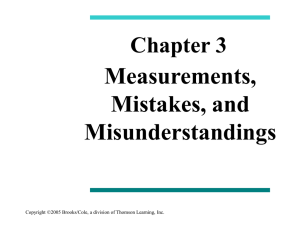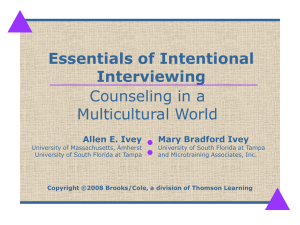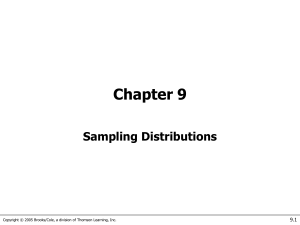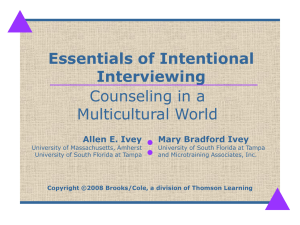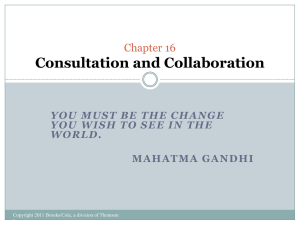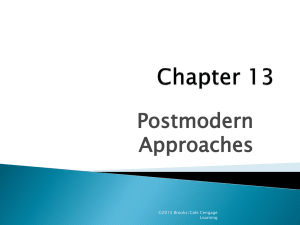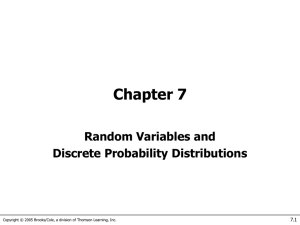Group Counseling
advertisement
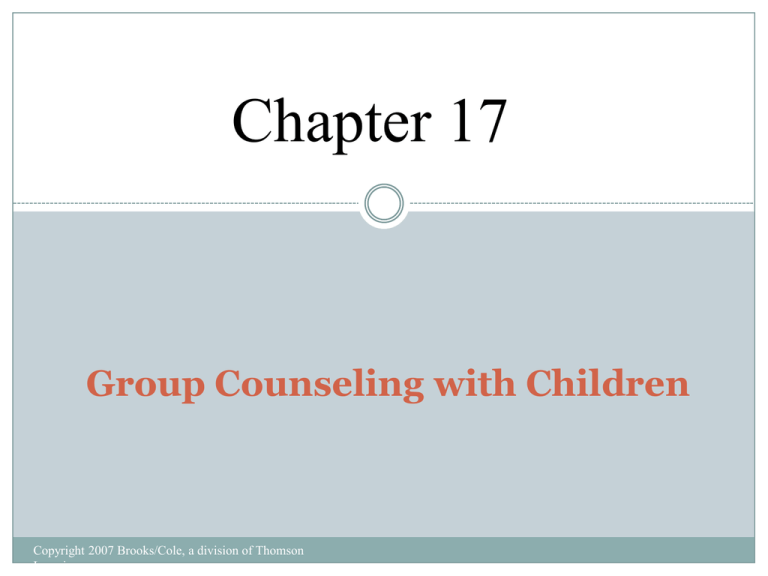
Chapter 17 Group Counseling with Children Copyright 2007 Brooks/Cole, a division of Thomson Learning Definition Gladding defined a group as “a collection of two or more individuals who meet in face-to-face interaction, interdependently, with the awareness that each belongs to the group and for the purpose of achieving mutually agreed-on goals.” Copyright 2007 Brooks/Cole, a division of Thomson Learning Types of Groups Psychoeducation: Use educational methods to obtain information and develop meaning and skills. Counseling: growth oriented for members generally being normal people who are experiencing stress in their life. Group therapy: focus on remediation and treatment of those who are severely disturbed or who are exhibiting socially deviant behavior. Copyright 2007 Brooks/Cole, a division of Thomson Learning Group Counselor Tasks Knowledge and use of counseling skills and techniques Direct communication traffic Facilitate the group process Block harmful group behaviors Connect ideas Obtain a consensus Moderate discussion Summarize Support children who need encouragement and reinforcement Copyright 2007 Brooks/Cole, a division of Thomson Learning Theoretically Oriented Group Counseling Adlerian Reality Therapy Behavioral Rational emotive behavior Transactional analysis Gestalt therapy Copyright 2007 Brooks/Cole, a division of Thomson Learning Theory used in Group Counseling: Adlerian Focus on person’s history to understand how individuals have created their lifestyle Delves into the early childhood to work forward. Individuals are seen as social beings who do best in groups Groups work together on cooperative tasks to make improvements in their lives. Copyright 2007 Brooks/Cole, a division of Thomson Learning Theory used in Group Counseling: Reality Therapy Focuses on the ideas of belonging, power, freedom, and fun. Group is microcosm of real world. By acting in the group in a changed manner, change will generalize. Members provide feedback to each other about behavior and plans for change. Copyright 2007 Brooks/Cole, a division of Thomson Learning Theory used in Group Counseling: Behavioral Counseling Members help each other by providing feedback or reinforcement to change maladaptive behaviors Directive leader who provides instruction for the training and helps establish any behavioral modification plans. Use techniques such as: training, positive reinforcement, extinction, desensitization, and modeling. Copyright 2007 Brooks/Cole, a division of Thomson Learning Theory used in Group Counseling: REBT Members recognize and confront irrational thoughts, and use feedback to learn new social skills Leaders are role models for responsible, reality-oriented behavior. Helps students understand moods and solve problems. Copyright 2007 Brooks/Cole, a division of Thomson Learning Theory used in Group Counseling: Transactional Analysis (TA) TA therapists prefer to use this theory in groups Used in groups that simulate life’s interactions by having the participates simulate a previous or real world event. The group members then analyze the interaction between the individuals represented and generate reasons why it happened the way it did and how it could’ve been improved. Great for social skills training. Copyright 2007 Brooks/Cole, a division of Thomson Learning Theory used in Group Counseling: Gestalt Focus on one volunteer client in a group at a time Does not explore the past, instead it focuses on the “here and now.” The leader must plan structured interactions to be successful. Example: Hot seat technique Copyright 2007 Brooks/Cole, a division of Thomson Learning Group Leadership Skills (Association for Specialists in Group Work) Encourage the participation of group members. Observe and identify group process events. Pay attention to and acknowledge the behavior of group members. Clarify and summarize statements. Begin and end group sessions. Give information when needed. Copyright 2007 Brooks/Cole, a division of Thomson Learning Group Leadership Skills (Association for Specialists in Group Work) Model effective behavior. Engage in appropriate self-disclosure. Receive and deliver feedback. Ask open-ended questions. Empathize with members. Confront group members’ behavior. Copyright 2007 Brooks/Cole, a division of Thomson Learning Group Leadership Skills (Association for Specialists in Group Work) Help members recognize the meaning of an experience. Help group members integrate and apply what they learn. Demonstrate ethical and professional standards. Keep the group focused on accomplishing its goals. Copyright 2007 Brooks/Cole, a division of Thomson Learning Leader Characteristics (Corey) Presence – genuine care in “being there” for clients Personal power – self confidence and awareness of one’s power Courage – ability to take risks and be vulnerable Willingness to confront oneself – being honest and self aware Sincerity and authenticity – sincere interest in the well-being of others and behaving without pretense Sense of identity – knowing one’s values, strengths, and limitations Belief and enthusiasm for the group process Inventiveness and creativity – open to new ideas and experience Copyright 2007 Brooks/Cole, a division of Thomson Learning Group Focus Remedial Study skills Listening skills Overcoming test anxiety Support Personal problems Parental divorce Bad habits New school Copyright 2007 Brooks/Cole, a division of Thomson Learning Preventative Problem-solving Anger management Handling stress Greenberg (2003) Group Focus Developmental Personal identity Relationships Emotional and behavioral development Academic achievement Career planning Bergin (2004) Copyright 2007 Brooks/Cole, a division of Thomson Learning Problem-centered (here and now) Relationships Conflicts with authority figures, peer groups Dating Sexual matters Balancing commitments Topic specific Grief and loss Divorce and separation Suicide Teen parenting Starting a Group Selecting group members Heterogeneous/Homogenous Appropriateness of group due to behavior Gender balance Recruiting a Group Screening interview Size of a group Group setting Copyright 2007 Brooks/Cole, a division of Thomson Learning GROUP STAGES (Gladding and Corey) Initial stage (Orientation and exploration): Get acquainted Determine structure of group Explore members’ expectations Transition stage (Challenge and resistance occurs): Group leader may be challenged Increased anxiety in members Copyright 2007 Brooks/Cole, a division of Thomson Learning GROUP STAGES (Gladding and Corey) Working stage (Cohesion and productivity occurs): Members focus on identifying goals and concerns Work on goals in group and outside of group Practice new behaviors Copyright 2007 Brooks/Cole, a division of Thomson Learning Group Counseling Process First session: Clarify ground rules and guidelines. Build cohesiveness and trust. Discuss confidentiality. Discuss active listening for each other. Copyright 2007 Brooks/Cole, a division of Thomson Learning Group Counseling Process Remaining sessions: Summary of the initial meeting. Establish therapeutic atmosphere. Leader models facilitative behaviors. Establish a relationship. Address members’ concerns/problems. Explore previous solutions, look at alternatives. Set goals, try new behaviors, assign homework Report and evaluate results Copyright 2007 Brooks/Cole, a division of Thomson Learning Implications for Different Ages Group counseling can help children in formative years acquire social skills, improve racial relationships, and shape a positive attitude towards school. Group counseling can support preadolescents in dealing with family, peer pressure, and anger management. Copyright 2007 Brooks/Cole, a division of Thomson Learning Implications for Different Ages Group counseling can help high school students with making choices, stress, aggression, and eating disorders. Group counseling can help students with self- esteem, self-determination, body awareness, and self-concept (ex. unity model). Copyright 2007 Brooks/Cole, a division of Thomson Learning Evaluation of Groups Questions to guide assessing effectiveness: What did we set out to accomplish? How did the participants respond? What participant behavior changed outside the group? How effective was the leader? Copyright 2007 Brooks/Cole, a division of Thomson Learning Evaluation of Groups 1. Assess leader’s effectiveness by the answers to the three previous questions. Other ways to assess include: 2. Observations by colleagues 3. Self-reflection 4. Input from group members: rating scales and other instruments Copyright 2007 Brooks/Cole, a division of Thomson Learning Classroom Meetings 1. 2. 3. 4. 5. 6. 7. 8. 9. 10. 11. Identify topic Ask for definitions Ask for specifics Ask for personal examples Ask for agreements and disagreements Challenge the group Present hypothetical situations Withhold judgment Refrain from embarrassing questions Uphold rights Use problem-solve model to reach a resolution Copyright 2007 Brooks/Cole, a division of Thomson Learning (James and Gilliland ) Define the problem. Ensure the client’s physical and psychological safety. Provide support through verbal and nonverbal means. Examine alternatives. Make plans – definite action steps. Obtain client’s commitment to take positive action. Copyright 2007 Brooks/Cole, a division of Thomson Learning Counselor Responsibilities Evaluate severity of crisis in client’s perception. Appraise the client’s thinking, feelings, and behaviors. Determine the danger and length of time in the crisis mode. Look for contributing factors. Evaluate resources. Copyright 2007 Brooks/Cole, a division of Thomson Learning INTERVENTION PHASES Introductory phase Fact phase Feeling phase Symptoms phase Teaching phase Summary phase Copyright 2007 Brooks/Cole, a division of Thomson Learning Introductory Phase Ask members to introduce themselves and tell why they are in the group. Help members clarify their goals regarding what they would like to accomplish in the meeting. Discuss confidentiality – what group members talk about stays in the group. Get a commitment from all members to maintain confidentiality. Copyright 2007 Brooks/Cole, a division of Thomson Learning Introductory Phase Discuss basic rules: 1. Take a bathroom break first because no one can leave the room after the group begins. 2. Encourage group members to stay the entire time. The group generally runs 2 hours; the time depends on the ages of the children. 3. Elect or appoint a co-leader or a peer leader to keep the gate (that is, not let people in or out). 4. Remind the group that no group member holds rank over any other group member and that everyone’s participation is valued equally. Copyright 2007 Brooks/Cole, a division of Thomson Learning Intervention Phases Fact Phase Focus on discussing what happened. Encourage everyone to participate. Feeling Phase Ask, “What happened then?” Ask, “What are you experiencing now?” Copyright 2007 Brooks/Cole, a division of Thomson Learning Intervention Phases Clients’ Symptoms Ask, “How is this affecting you?” (Is the member having trouble sleeping, studying, or is the member worrying too much?). Ask, “How is this affecting your grades, your studies, your health?” Copyright 2007 Brooks/Cole, a division of Thomson Learning Intervention Phases Teaching Phase Explore the common responses to this incident. Brainstorm about how people have been responding to the incident. Discuss how each response is helpful or not helpful to people. Copyright 2007 Brooks/Cole, a division of Thomson Learning Intervention Phases Summary Phase Raise questions and provide answers. Summarize what has been learned and shared. Develop action plans for individuals and/or the group, if needed. Copyright 2007 Brooks/Cole, a division of Thomson Learning Intervention Phases Summary Stage Provide support for group members to ensure their physical, emotional, and psychological safety. An action plan should be made to protect any group member needing protection. Conduct a follow-up meeting in 3 to 5 days to see how well the group members are coping. Arrange individual counseling sessions for group members who need further assistance. Copyright 2007 Brooks/Cole, a division of Thomson Learning
